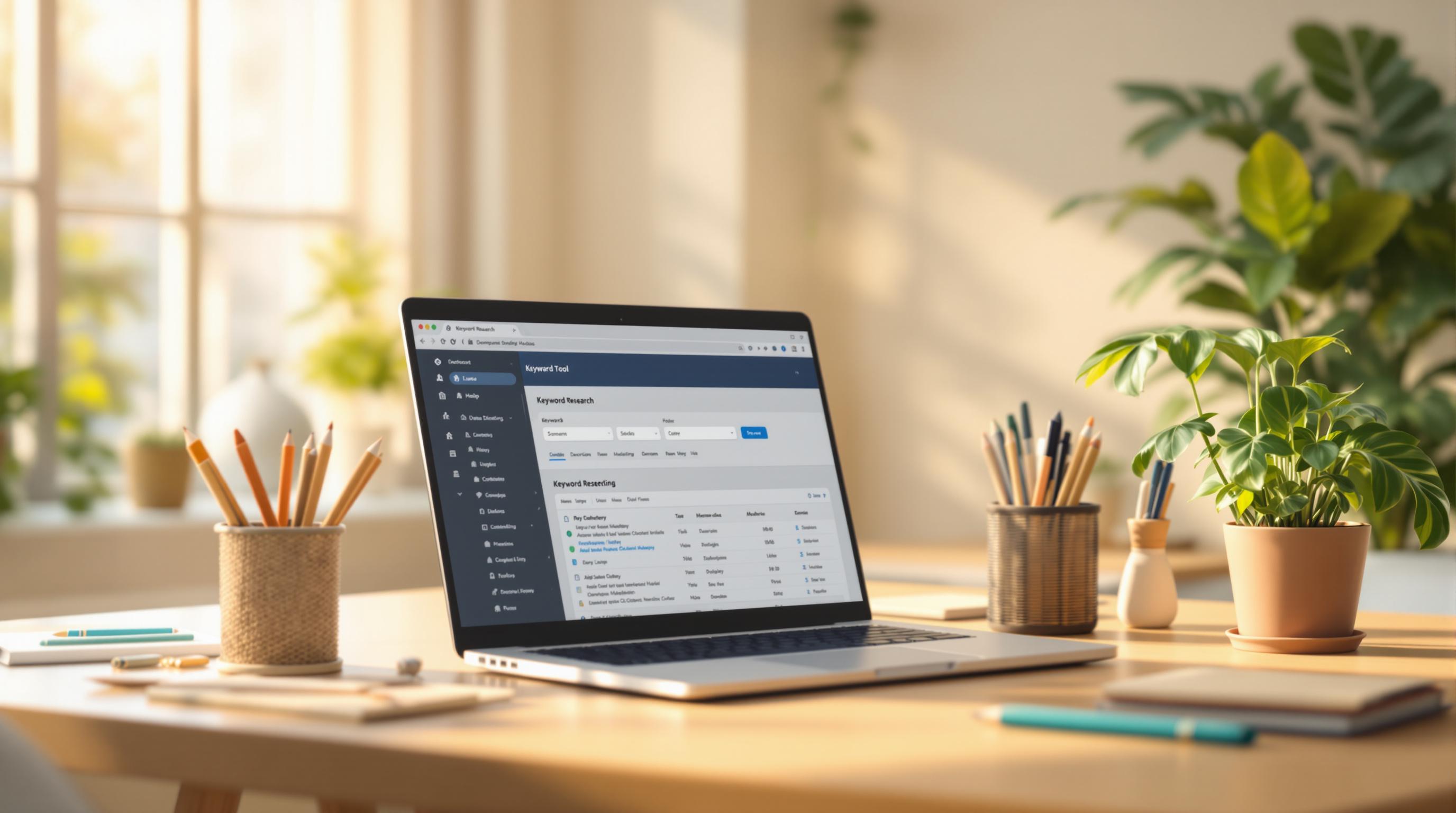Understanding your competitor's audience is essential for staying ahead in 2025. Businesses using audience analysis tools report 2.5× better performance, with 85% making improved decisions. These tools help identify trends, market gaps, and audience preferences, enabling smarter strategies. Below are the top tools for competitor audience analysis this year:
- SparkToro: Explore audience demographics, online behavior, and competitor insights.
- Semrush: Analyze traffic, demographics, and competitor strategies with advanced SEO tools.
- Similarweb: Gain insights into website traffic, audience profiles, and referral sources.
- Sprout Social: Track social media trends, engagement, and competitor performance.
- Ahrefs: Focus on SEO, backlinks, and keyword strategies for deep competitor analysis.
- BuzzSumo: Evaluate content performance, social shares, and emerging trends.
- Google Analytics: Leverage free tools for audience behavior and benchmarking.
Quick Comparison:
| Tool | Starting Price | Key Features | Best For | Limitations |
|---|---|---|---|---|
| SparkToro | $38/month | Audience behavior, competitor insights | Audience research | Limited SEO features |
| Semrush | $139.95/month | SEO, traffic, and competitor data | Comprehensive marketing | Higher cost for small teams |
| Similarweb | $199/month | Traffic, demographics, referrals | Enterprise-level insights | Expensive for smaller businesses |
| Sprout Social | $199/user/month | Social media tracking, sentiment | Social media-focused strategies | High per-user pricing |
| Ahrefs | $129/month | Backlinks, SEO, keyword analysis | SEO and content strategies | Steep learning curve |
| BuzzSumo | $199/month | Content performance, social trends | Content marketing teams | Limited data export options |
| Google Analytics | Free (GA4) | Behavior tracking, benchmarking | Budget-conscious users | No direct competitor data |
Each tool offers unique strengths, so choose based on your goals, budget, and focus areas. For smaller budgets, Google Analytics provides free insights, while SparkToro and Ahrefs cater to audience and SEO needs. Larger teams may benefit from the extensive data of Similarweb or Semrush. Start with free trials to find the best fit for your strategy.
Similarweb - Free Competitor Analysis Tool
1. SparkToro
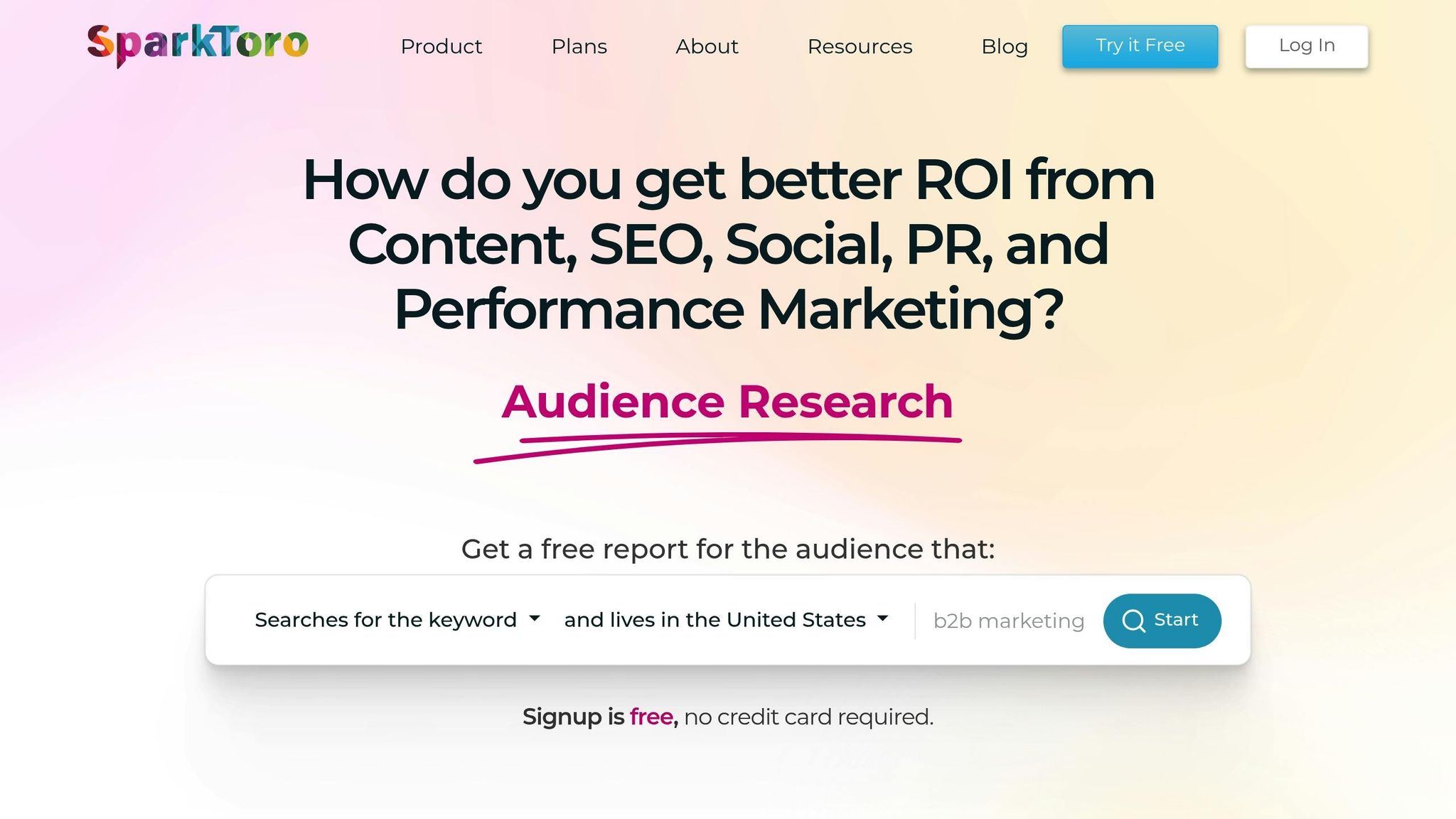
SparkToro is a standout tool for audience research, offering a unique way to uncover where your competitors' audiences spend their time online and how they engage across various platforms. Here's a closer look at how SparkToro provides detailed audience insights and competitor analysis capabilities.
Audience Insights
SparkToro dives deep into audience demographics, providing data on gender, age, education, skills, and interests for any search query. Beyond demographics, it pinpoints where audiences are active - whether it's on social networks, apps, Subreddits, podcasts, or YouTube channels - giving you a clear picture of their online behavior. The platform also reveals the language and terminology competitor audiences use in their bios and content. This helps you understand not only who your audience is but also how they communicate and what resonates with them. Armed with this knowledge, you can craft highly targeted messaging strategies that align with your findings.
"SparkToro is the best marketing tool for startups. A startup can't and shouldn't spend time on marketing until they know who their audience is, who is already influencing them, and what content they're interested in." - Vinny La Barbera, Founder & CEO, imFORZA
Competitor Analysis Features
SparkToro takes audience research a step further by offering robust competitor analysis tools. By simply entering a competitor's URL, you can uncover insights about their audience across social media platforms, PR channels, and website visitors. The tool identifies content ideas, keyword opportunities, and backlink prospects based on where competitor audiences are most active. One of its standout features is its ability to highlight hidden backlink opportunities by suggesting sites with lower traffic that still attract your competitors' audience.
Using a combination of clickstream and social data, SparkToro provides a complete view of competitor activity. It even tracks trends over the past two years using clickstream data from Datos, helping you identify long-term patterns. This makes it an invaluable resource for spotting engagement trends and uncovering untapped opportunities.
"This is the best audience research tool on the market. Period. I use it before launching any content marketing campaign. Heck, I even use it before launching any SEO campaign, any social media marketing campaign, any influencer marketing campaign, or any Digital PR campaign." - Greg Jarboe, President and Co-founder, SEO PR
Integration Capabilities
SparkToro doesn’t just provide insights - it makes them actionable. The tool builds data-driven personas based on real customer behaviors and demographics. These personas can be directly applied to ad platforms like Facebook and Twitter, making it easier to create targeted paid campaigns. This seamless integration allows you to turn competitor audience insights into effective marketing strategies.
"SparkToro is an essential audience research tool that does things nothing else does. I've used it to identify audience affinities I can use to build out Facebook Advertising audiences, and Twitter ad targeting (which we've found to be an amazing way to reach people)." - Ciaran Rogers, Marketing Director, Target Internet
In addition to audience research, SparkToro supports tasks like social listening, search intent analysis, and leveraging AI-powered insights. However, it’s worth noting that it doesn’t offer in-depth backlink data, keyword rankings, or technical SEO features like some dedicated SEO tools.
Pricing (USD)
SparkToro offers flexible pricing options, including a free plan for testing the platform. Paid plans come with a 25% discount when billed annually.
- Personal Plan: $38/month (or $450 annually). Includes 50 searches per month, top 50 results for keywords and social accounts, top 10 results for podcasts and YouTube, limited demographic insights, and unlimited list building.
- Business Plan: $112/month (or $1,344 annually). Designed for up to 10 users, it offers 500 searches per month, top 150 results across all search types, complete demographic data, and access to email/social contact information.
- Agency Plan: $225/month (or $2,700 annually). Ideal for larger teams, it provides unlimited searches for up to 100 users, top 300 results, full CSV exports, custom audiences, and advanced search capabilities.
The Personal plan is a great fit for small businesses and consultants. The Business plan works well for in-house marketers and small agencies, while the Agency plan is tailored for larger teams with extensive research needs.
2. Semrush
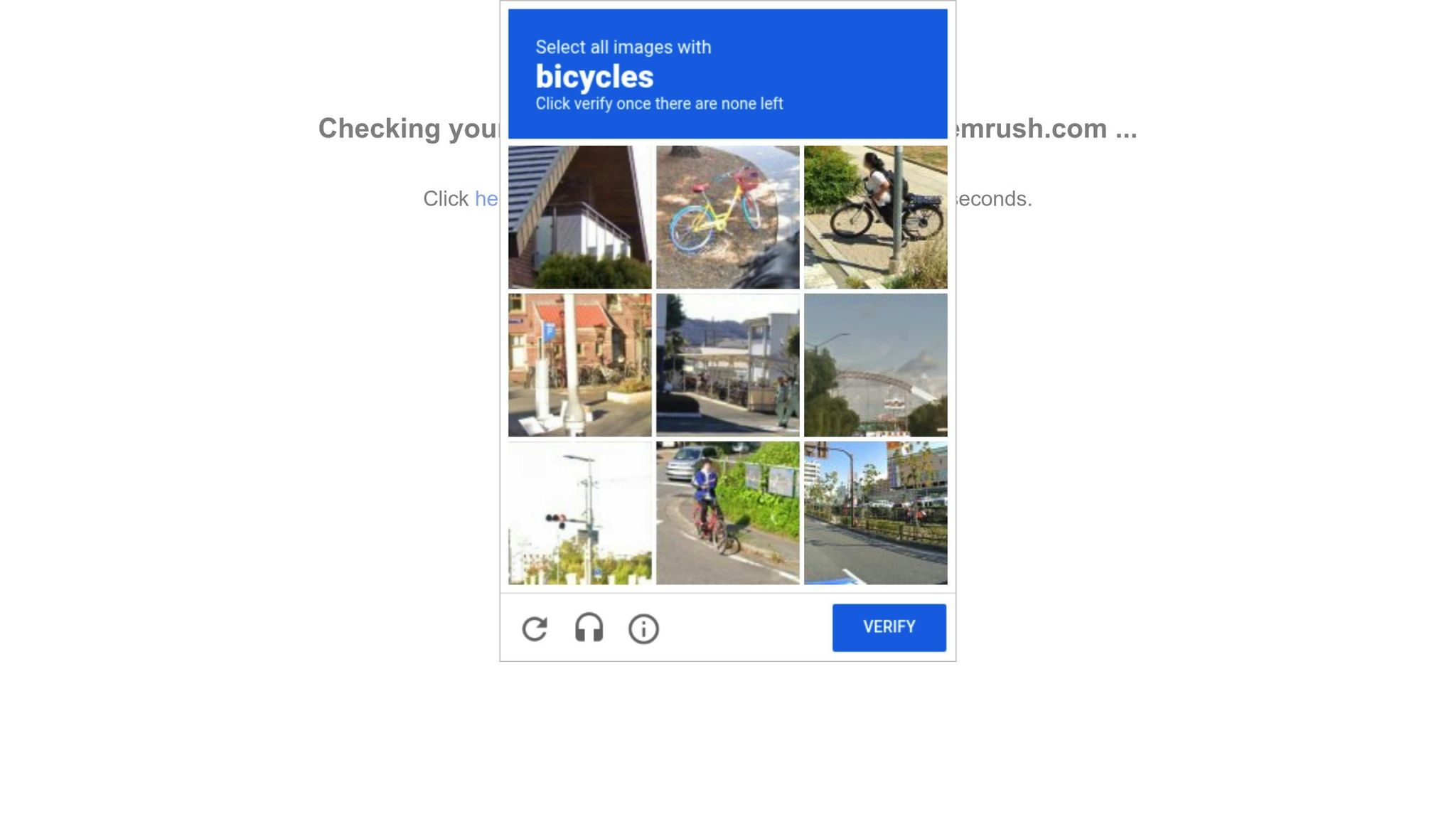
Semrush is a competitive intelligence platform used by over 950,000 users worldwide. It helps marketers dive deep into competitor audience insights and behaviors, offering tools that consolidate market, competitor, and audience data into one place through its Traffic & Market Toolkit. These insights give marketers a strong foundation for building effective strategies.
Audience Insights
Semrush provides detailed audience intelligence through specialized dashboards. For instance:
- The Demographics dashboard breaks down data like gender, age, education, and interests.
- The Regional Trends panel highlights geographic patterns.
- The Audience Overlap feature identifies audiences shared between competitors.
- Sources & Destinations maps out how audiences navigate to and from competitor websites.
The Market Explorer tool goes even deeper, revealing audience demographics, interests, and preferred social media platforms for any competitor. Additionally, the One2Target tool offers socioeconomic insights, enabling businesses to refine pricing strategies based on competitor audience data.
"To create a content strategy that truly drives results, you must understand what resonates with your audience, stay informed on your competitors' strategies, and effectively distribute your content within your unique market." - Semrush
Semrush also tracks user experience metrics such as Pages per Visit, Average Visit Duration, and Bounce Rate. These metrics help businesses identify content gaps and potential areas for improvement.
Competitor Analysis Features
Semrush builds on its audience insights by offering tools to analyze competitor strategies. It tracks traffic across various channels, including referral, search, social, and email. The AI Traffic dashboard even monitors how AI assistants reference competitor brands. For a global perspective, the Countries dashboard visualizes how competitor traffic flows across different regions over time.
The Semrush Social tool provides a detailed look at competitors' social media performance, analyzing audience engagement, activity, and follower growth. Meanwhile, the Semrush Copilot, an AI-powered assistant, integrates with other tools to track competitor insights and suggest actionable strategies.
Integration Capabilities
Semrush excels at turning insights into strategies. For example:
- The SEO Content Template generates recommendations for SEO-friendly content based on target keywords and competitor analysis.
- The Topic Research Tool identifies trending topics and common questions within competitors' content strategies.
By leveraging audience insights, businesses can discover untapped segments and fine-tune their publishing strategies. The Audience Intelligence App further identifies audience behaviors, interests, and the influencers competitors rely on.
Case studies highlight Semrush's impact: one brand adjusted its demographic targeting based on audience insights, while another successfully collaborated with influencers to reach new market segments.
Pricing (USD)
Semrush offers several pricing plans, along with annual billing discounts and a 7-day money-back guarantee:
- Pro Plan: $139.95/month (or $117.33/month billed annually) – ideal for individuals and small teams.
- Guru Plan: $249.95/month (or $208.33/month billed annually) – designed for growing businesses and mid-sized agencies.
- Business Plan: $499.95/month (or $416.66/month billed annually) – tailored for large agencies and enterprises.
The Traffic & Market Toolkit is available for $289/month, while additional toolkits include the Social Toolkit starting at $20/month and the AI Toolkit at $99/month per domain.
Semrush has earned a 4.7/5 rating on Capterra from over 2,255 user reviews. It also offers a free plan with limited features and provides discounts for non-profits.
3. Similarweb
Founded in 2007 and based in Tel Aviv, Similarweb provides detailed insights into website traffic and audience behavior across various industries.
Audience Insights
Similarweb helps businesses understand their competitors' audience profiles with detailed demographic data, including age ranges, geographic locations, and visitor origins. The platform also offers user affinity analysis, revealing topics and website categories that resonate with specific audiences. Its "Also Visited Websites" feature pinpoints other sites frequently browsed by these users. Key metrics like total visits, unique visitors, and traffic sources are tracked, with geographic data breaking down visitor distribution by region and country. These insights enable businesses to craft more targeted strategies.
"SimilarWeb gives users global multi-device market intelligence to understand, track and grow the digital market share. It empowers users with the insights users need to win the market."
– Limor Barenholtz, Director of SEO at Similarweb
Competitor Analysis Features
Beyond audience insights, Similarweb offers robust tools for competitor analysis. It reveals how competitors attract customers through both paid and organic channels. Businesses can benchmark their performance by examining competitors' best-performing pages, top referral sites, and advertising strategies. The platform also provides insights into leading mobile apps within specific industries.
In July 2025, MADX Digital illustrated Similarweb's capabilities when a SaaS company used it to analyze backlink data and referral traffic sources, uncovering opportunities to refine its strategy.
"SimilarWeb is a leading digital intelligence platform that empowers businesses to make data-driven decisions."
– Toni Koraza, The SEO guy, MADX Digital
The platform's visualization tools turn data into easy-to-read charts and dashboards, helping users identify which blogs or influencers are driving traffic to competitors. These insights integrate seamlessly with Similarweb's broader tools.
Integration Capabilities
Similarweb compiles data from a variety of sources, including browser extensions, mobile apps, public data, and third-party providers. This enables businesses to focus on areas like marketing, sales, investing, or eCommerce. Additional features, such as AI Traffic analysis, Market Research tools, and Conversion Analysis, can be added to enhance its functionality.
Pricing (USD)
Web Intelligence
- Starter: $199/month or $1,500/year
- Team: From $14,000/year
- Business: From $35,000/year
- Enterprise: Custom pricing
Sales Intelligence
- Individual: $129/month or $1,200/year
- Business: From $16,000/year
- Enterprise: Custom pricing
Shopper Intelligence
- Starter: From $15,000/year
- Business: From $25,000/year
- Enterprise: Custom pricing
Both App Intelligence and Stock Intelligence require custom pricing discussions.
Similarweb offers a 7-day free trial (credit card required) and freemium tools for basic analysis. The platform has earned high ratings: 4.5/5 stars on G2 (with over 1,000 reviews), 8/10 on TrustRadius, and 4.5/5 stars on Capterra.
4. Sprout Social
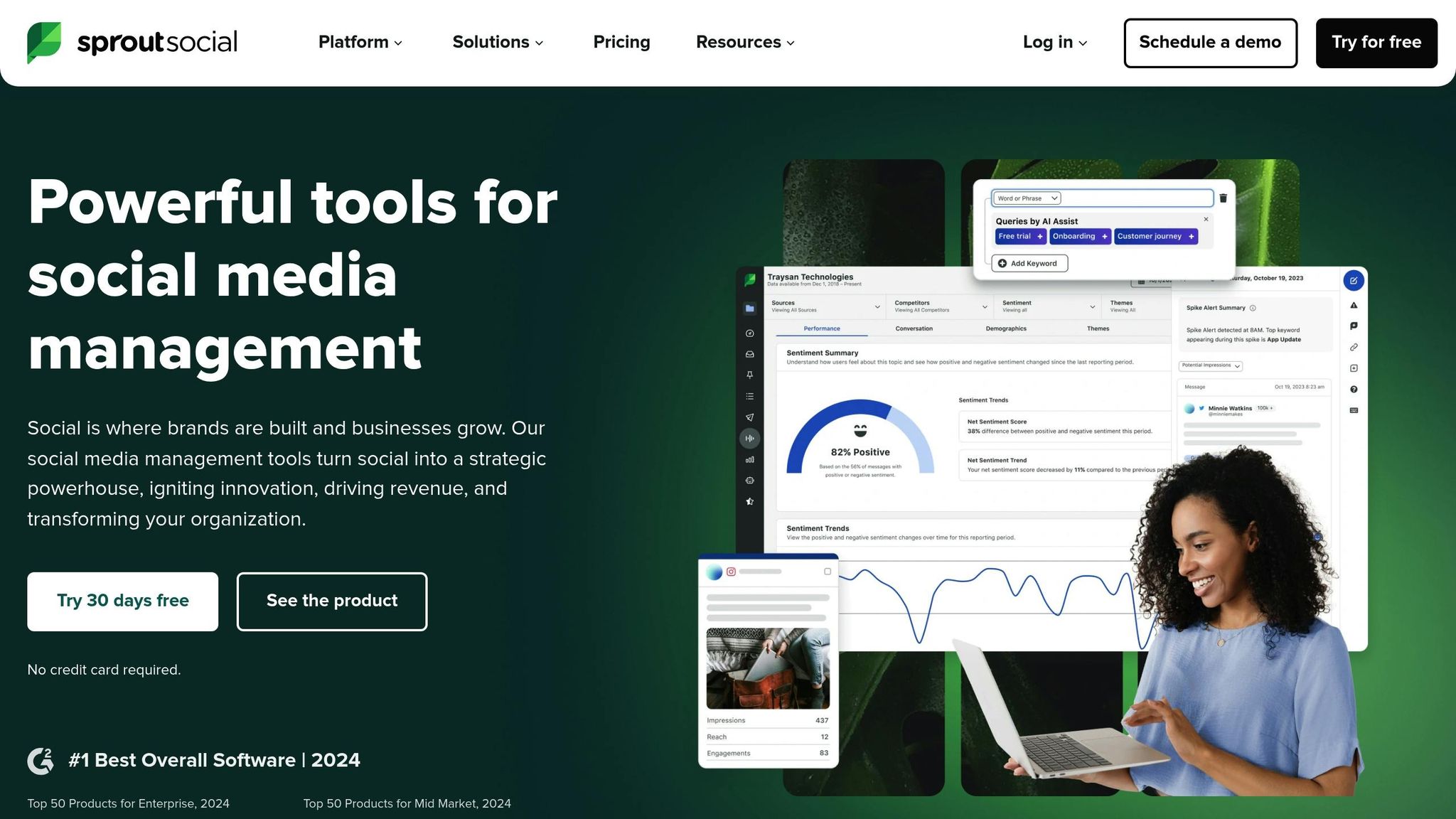
Sprout Social is a comprehensive social media management tool that now provides advanced competitor audience analysis through its social listening features and performance tracking capabilities.
Audience Insights
Sprout Social's listening tools analyze millions of data points to uncover valuable insights about competitors and brands. These tools track audience growth, engagement, and sentiment, offering a clear view of trends and competitor performance. The sentiment analysis feature is especially helpful in understanding how audiences feel about brands and their competitors. For instance, Trek Bicycles uses Sprout Social's Advanced Listening tools to spot trends by analyzing social conversations before they gain widespread attention.
"We're trying to get more data inputs directly from consumers. What we are trying to do is make more informed decisions by being better listeners."
– Eric Rosch, Digital Marketing Manager, Trek Bicycles
These insights naturally support strategic comparisons with competitors.
Competitor Analysis Features
Sprout Social provides detailed competitor reports that compare key performance metrics side by side, including share of voice, engagement rates, sentiment scores, and total impressions. The platform also identifies top trends, topics, and posts in your industry, with filtering options for competitor, content type, message type, and sentiment. For example, James Hardie uses Sprout Social's listening tools to keep track of brand conversations and maintain a leading share of voice within their industry.
"Listening not only helps us better understand what the conversations are about our brand in the digital space, it lets us make sure we're dominating share of voice in our industry in a relevant, impactful and positive way."
– Kara Wenman, Digital Marketing Manager, James Hardie
The platform also highlights keywords, hashtags, and influential thought leaders in relevant conversations. Minor Hotels uses these insights to adapt its social media strategy on the fly.
"Because social media changes every day, we find the competitors we can pull directly from Sprout Social helps a lot. We can monitor timely social media trends, see what our competitors are doing and adjust our strategy accordingly."
– Acharee Punyashthiti, Assistant Director, Social Media and Advertising, Minor Hotels
Integration Capabilities
Sprout Social extends its functionality by integrating with various platforms, making data-driven decisions easier. It connects with major social networks like Facebook, Instagram, X (Twitter), and YouTube for publishing and monitoring. Additionally, it integrates with business intelligence tools such as Salesforce and Tableau for custom reporting. Other integrations include CRM platforms like HubSpot, help desk systems like Zendesk, and analytics tools such as Google Analytics. Workflow tools like Slack and digital asset management platforms such as Canva and Dropbox are also supported, allowing teams to streamline communication and manage assets efficiently.
James Hardie uses these integrations to channel insights from Sprout Social into multiple departments, including sales, product development, and customer care.
"Not only is it good from a brand health and marketing angle, it's also important information we can pass on to our sales teams and product teams. We can find trends and common themes that come up in conversations. We can identify not only our own brand advocates, but brand advocates for our competition."
– Bridget Kulla, Senior Digital Marketing Manager, James Hardie
By combining advanced social listening tools with seamless integrations, Sprout Social empowers marketers to stay ahead with actionable insights.
Pricing (USD)
Sprout Social's pricing depends on the number of users and the billing plan:
- Standard: $199 per user/month (billed annually) or $249 per user/month (billed monthly) – includes 5 social profiles
- Professional: $299 per user/month (billed annually) or $399 per user/month (billed monthly) – unlimited social profiles
- Advanced: $399 per user/month (billed annually) or $499 per user/month (billed monthly) – unlimited social profiles
- Enterprise: Custom pricing – unlimited social profiles
Additional features like Premium Analytics, Listening tools, and Employee Advocacy can be added for an extra cost. A 30-day free trial is available to explore publishing and analytics features, while social listening tools are included in custom enterprise plans. Non-profits may qualify for discounts on Professional and Advanced plans.
sbb-itb-5be333f
5. Ahrefs
Ahrefs is a standout tool in the world of SEO, particularly for competitor analysis. It gives users access to an extensive database, with 14 trillion live backlinks indexed and hundreds of millions of keywords tracked across 189 locations. This makes it a go-to resource for businesses looking to understand competitor strategies and audience behavior.
Audience Insights
Ahrefs excels at uncovering what your target audience is searching for. With over 171 million keywords monitored in the U.S. alone, it provides businesses with a clear view of search trends and customer interests. Its keyword research tools pinpoint the exact terms potential customers use when searching for products or services, making it easier to align content with audience needs.
The platform also identifies high-performing content, revealing which topics and formats resonate most with your audience. This insight helps businesses find untapped opportunities, refine their content strategies, and create pieces that match both search demand and audience preferences.
Ahrefs even dives into data about featured snippets, which attract about 8.6% of clicks, compared to 19.6% for the first organic result. This can guide businesses in optimizing their content to capture these valuable positions in search results.
Competitor Analysis Features
Ahrefs goes beyond basic metrics, offering a deep dive into competitor performance. Users can compare entire domains to uncover new topics or analyze individual pages to identify missing subtopics. SEO consultant Ben Poulton highlights its practical value:
"Ahrefs is my go-to software for SEO, and their functionalities for competitor analyses are super helpful right out of the gate. I can create detailed reports on competitive benchmarking by keyword and category. These help me and clients quickly spot gaps, underperforming areas, or highly competitive terms we do well on, but want to make sure we maintain."
The platform’s backlink analysis is another standout feature. Using one of the fastest backlink crawlers in the industry, Ahrefs shows exactly where competitors are earning links, enabling businesses to replicate successful strategies and explore similar opportunities. It also tracks your organic share of voice compared to competitors, offering a clear picture of your market position. For even more targeted strategies, Ahrefs can identify podcasts popular with competitor audiences, opening doors to sponsorships and engagement opportunities.
Pricing (USD)
Ahrefs offers four pricing plans, with discounts for annual payments:
- Lite: $129/month or $108/month (annual) - geared toward small businesses and individuals
- Standard: $249/month or $208/month (annual) - great for freelance SEOs and consultants
- Advanced: $449/month or $374/month (annual) - tailored for in-house marketing teams
- Enterprise: $1,499/month (annual commitment required) - best for agencies and large enterprises
For businesses focused on competitor analysis, the Standard and Advanced plans provide the most value with features like Content Explorer and Site Audit. While Ahrefs doesn’t offer a free trial, limited free access is available through its Webmaster Tools.
6. BuzzSumo
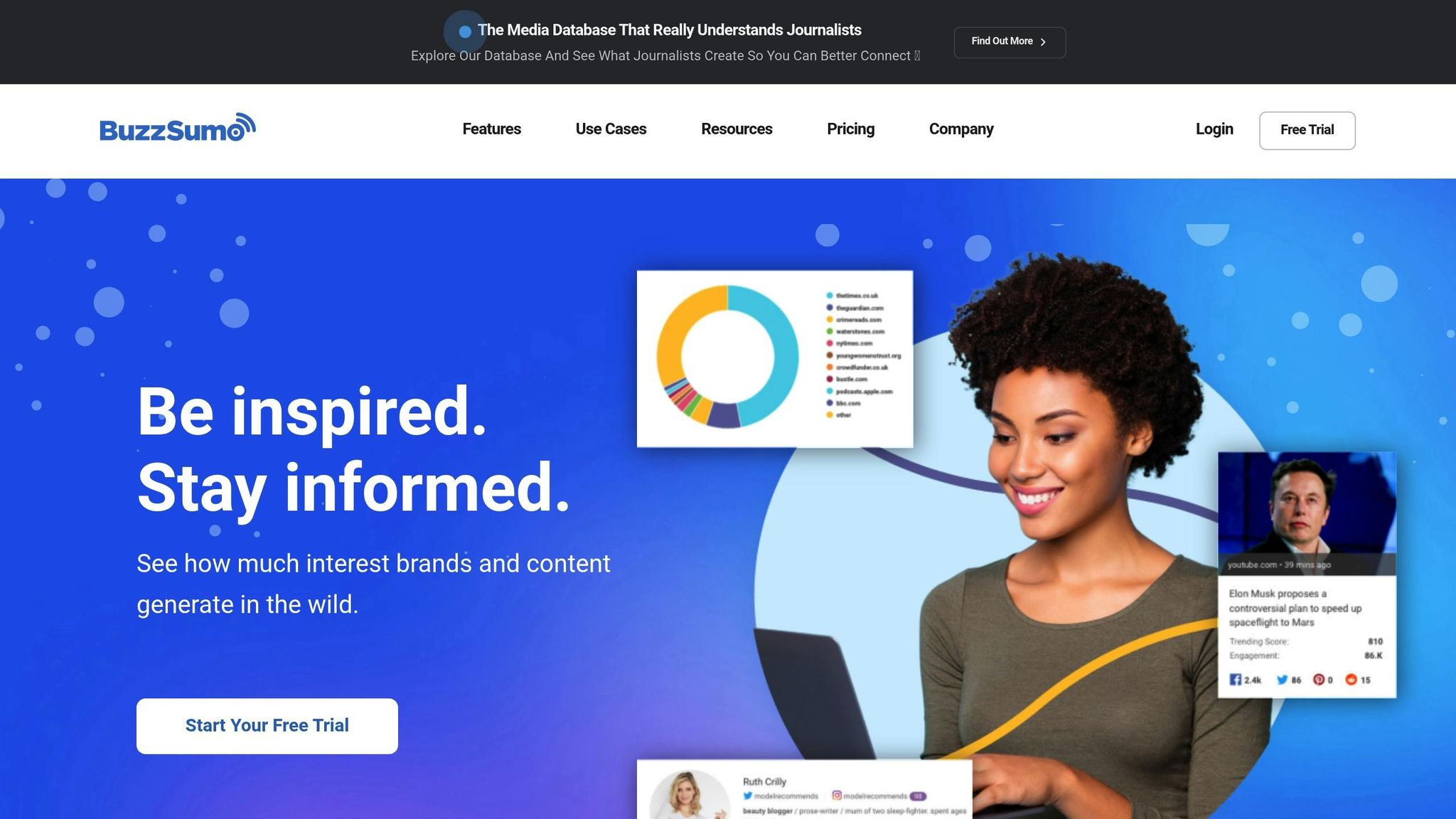
BuzzSumo is a content intelligence tool that tracks and analyzes the performance of over 8 billion articles across social platforms. By focusing on how content performs, it helps businesses anticipate competitor strategies and understand audience behavior, making it a valuable resource for 2025.
Audience Insights
BuzzSumo dives deep into social media content to reveal which formats, topics, and platforms generate the most engagement. Content Marketing Consultant Erika Heald highlights its value:
"What I love is that I'm able to use data, thanks to BuzzSumo, to help people gain a lot better understanding of who their audience is, and where they're actually engaging with content."
One standout feature is the Facebook Page Analyzer, which compares up to 10 competitor pages at once. It breaks down audience reactions, such as likes, shares, and comments, while segmenting data by post type, length, and publication date. This provides a clear picture of how competitors connect with their audiences.
BuzzSumo also measures the potential reach within specific niches. By identifying which content gains traction and goes viral, businesses can spot emerging trends and focus on topics that resonate with their audience. These insights naturally feed into a more strategic competitor analysis.
Competitor Analysis Features
When it comes to competitor analysis, BuzzSumo delivers detailed reports that can be filtered by network, content format, or even author. It provides insights into average shares, post performance, and key influencers amplifying competitor content. Rand Fishkin, Founder & CEO of SparkToro, explains its usefulness:
"I can search for terms/phrases and quickly identify content that's performing well in a niche or with an audience."
Another powerful feature is its real-time alert system, which notifies users whenever competitors are mentioned online or publish new content. It even identifies influential voices driving competitor engagement, opening doors for potential collaborations.
Integration Capabilities
BuzzSumo goes beyond analysis by integrating seamlessly into workflows. Higher-tier plans include Slack integration, allowing teams to receive content alerts and performance updates directly in their channels. Enterprise users also gain API access, making it easier to incorporate BuzzSumo's insights into larger marketing automation systems.
Pricing (USD)
BuzzSumo offers four pricing tiers tailored to different business needs:
- Content Creation: $199/month (billed annually) - 1 user, 2 alerts, 2 years of data, 2 custom trending feeds, unlimited searches
- PR & Comms: $299/month (billed annually) - adds a journalist database, coverage reports, and Slack integration
- Suite: $499/month (billed annually) - 10 users, 10 alerts, 30 custom trending feeds, 5 years of data
- Enterprise: $999/month (billed annually) - 30 users, 50 alerts, 5 years of data, and early access to new features
Discounts are available for NGOs, registered nonprofits, and educational institutions. While the cost may feel high for smaller businesses, many marketers find the insights invaluable for driving serious content strategies.
7. Google Analytics
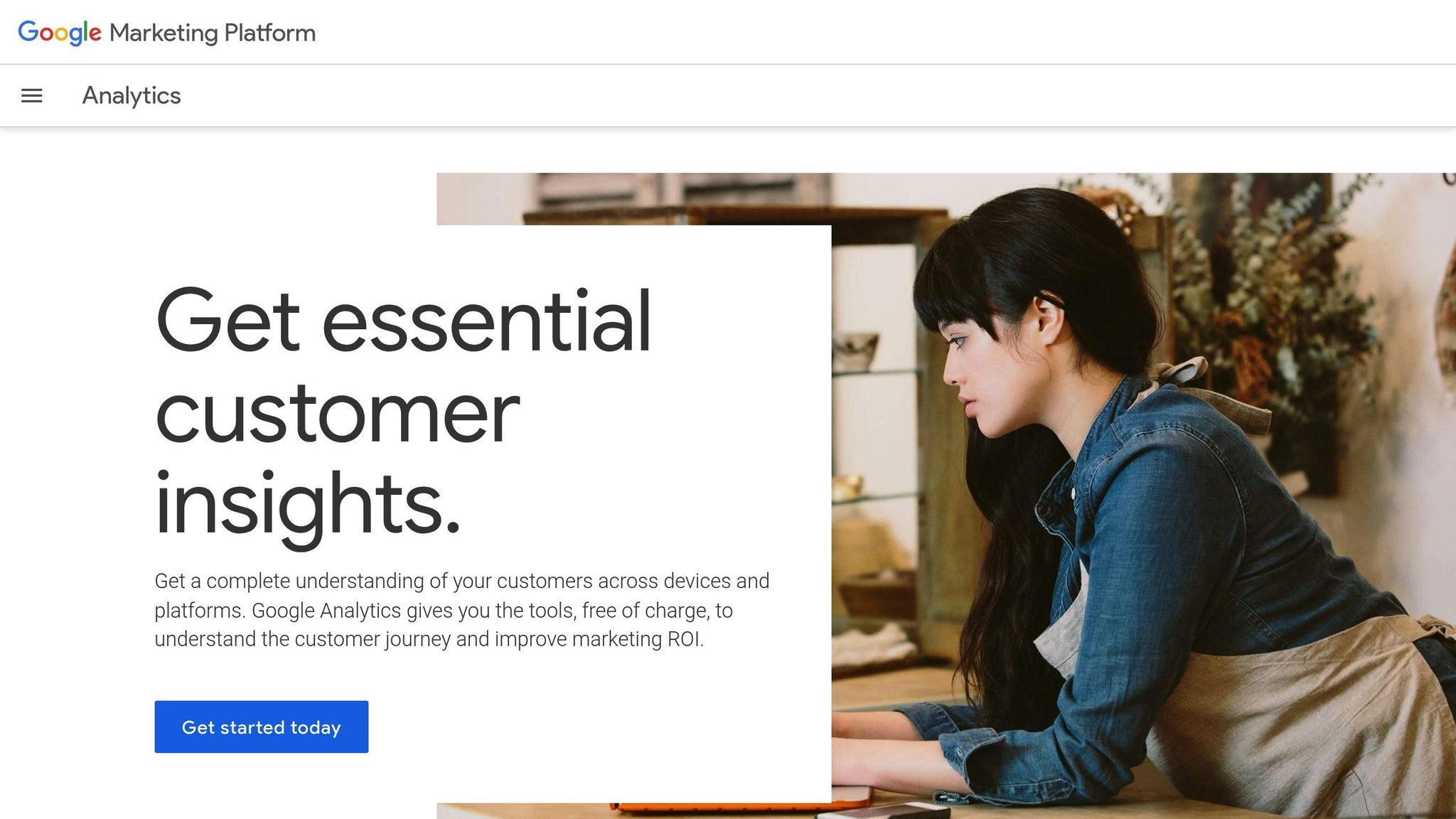
Google Analytics is a free and widely-used tool that provides valuable insights into audience behavior and market opportunities. While it doesn’t offer direct competitor data, it helps identify industry trends and potential gaps in your strategy.
Audience Insights
With Google Analytics, you can uncover audience behavior patterns that guide your competitive approach. The Benchmarking Reports allow you to compare your website's performance against industry averages, highlighting areas where competitors might have an edge. The Audience Interests reports are another useful feature, revealing topics and trends that resonate with your audience. This can help you spot content gaps and refine your strategy. For instance, in Q1 2025, Victorious leveraged GA4’s segmentation tools to pinpoint a profitable target group, showcasing the platform’s precision.
Additionally, tracking social media referral traffic can give you a sense of which platforms are driving the most engaged visitors to your site. This data offers clues about competitors' social media strategies, helping you refine your own.
Competitor Analysis Features
Though indirect, Google Analytics provides several features that can aid in competitor analysis. The Referral Traffic Report lets you see which external websites are driving traffic to your site, potentially identifying competitors or partners. When integrated with Google Search Console, you can access keyword data that sheds light on terms your competitors might be targeting. The Behavior Flow Reports highlight areas where your website may fall short in content or user experience, while custom alerts notify you of significant shifts in engagement metrics.
Integration Capabilities
Google Analytics 4 (GA4) offers seamless integration with tools like Google Ads and BigQuery, enhancing your ability to analyze campaigns and refine strategies. For deeper insights, exporting GA4 data to BigQuery allows you to apply machine learning models. For example, integrating with Vertex AI can help predict customer lifetime value, enabling smarter marketing investments. Additionally, GA4 connects with WordPress through plugins like Analytify, which display analytics insights directly on your dashboard. These integrations transform raw data into actionable insights, giving you a competitive edge.
Pricing (USD)
GA4 is free and ideal for small to medium-sized businesses. For larger enterprises, GA360 starts at $50,000 per year. However, additional event fees can push annual costs to between $200,000 and $300,000.
Tool Comparison Chart
Selecting the right competitor audience analysis tool hinges on your specific goals, budget, and team size. Below is a detailed comparison of six popular tools, complete with verified data, to guide your decision-making process.
| Tool | Starting Price (USD) | Main Strengths | Best For | Key Limitations |
|---|---|---|---|---|
| Semrush | $139.95/month | All-in-one SEO and PPC analysis | Comprehensive digital marketing | Higher price point for small businesses |
| Similarweb | $199/month | Website traffic and market share data | Enterprise-level intelligence | Costly for small businesses; limited historical data |
| Sprout Social | $199/month (annual billing) | Social media competitor tracking | Social media–focused businesses | Higher per-user cost |
| Ahrefs | $129/month | Backlink analysis and SEO research | In-depth SEO competitor analysis | Steep learning curve; basic reporting features |
| BuzzSumo | $159/month (annual billing) | Content performance analysis | Content marketing teams | Limited data export options; slight learning curve |
| Google Analytics | Free (with premium GA360 pricing) | Audience behavior insights | Budget-conscious businesses | Indirect competitor analysis only |
This table offers a snapshot of each tool's strengths and weaknesses, but there's more to consider when narrowing down your options.
Budget-Friendly Choices
For small businesses, Google Analytics stands out with its free tier, offering valuable audience insights without any upfront cost. Meanwhile, tools like Ahrefs and Semrush strike a balance by providing mid-range pricing with robust features for those ready to invest a bit more.
Enterprise-Level Solutions
Larger organizations often turn to Similarweb and Semrush for their extensive market intelligence capabilities. These tools are particularly suited for enterprises, though pricing for advanced features typically requires custom quotes.
Tailored Use Cases
Each tool serves a specific niche. For instance, Semrush is highly praised for its SEO and competitor analysis capabilities. Muhannad S., a Digital Marketing Manager, shared his experience:
"An incredible depth of data for SEO. The keyword research, competitor analysis, and site audit tools are especially useful for refining strategy and improving rankings. The interface is intuitive, and the reporting features help track progress effectively."
Accuracy and Performance
Modern AI-driven tools are known for their high accuracy, often achieving rates between 85% and 95%. This level of precision can be critical when making data-driven decisions.
Strategic Selection Tips
Sometimes, combining multiple tools is the smartest approach. For example, you might use Google Analytics to gather baseline insights, Ahrefs for deep SEO analysis, and Sprout Social to monitor social media competitors. This multi-tool strategy often delivers better ROI than relying on a single all-in-one solution.
If you're just starting out, consider beginning with free or low-cost options like Google Analytics to define your needs. As your business grows, you can scale up to more advanced tools that align with your expanding competitive intelligence requirements.
Conclusion
Selecting the right competitor audience analysis tool depends on your unique needs, budget, and long-term goals. The tools we've discussed range from Google Analytics, offering free baseline insights, to Similarweb, which provides enterprise-level market intelligence. Each tool plays a specific role in helping businesses shape strategies that align with their growth objectives.
If you're a small business working with limited resources, starting with free tools like Google Analytics is a smart move. These tools offer essential insights without requiring upfront investment, helping you establish basic monitoring processes.
For mid-sized businesses, platforms like Ahrefs or Semrush strike a balance between cost and functionality. These tools are ideal for companies looking to scale and need deeper insights into SEO, traffic, and competitor strategies.
Larger enterprises often find value in using a combination of tools rather than relying on a single solution. For example, you could use Google Analytics for audience behavior, Ahrefs for in-depth SEO analysis, and Sprout Social for tracking social media performance. This multi-tool approach can deliver a more comprehensive understanding of your market and maximize your return on investment.
Before choosing a tool, define your competitive goals. Are you focusing on SEO, strengthening your social media presence, or improving overall market positioning? Your priorities will guide your decision. For instance, if backlink analysis is your focus, Ahrefs is a strong contender. If you're after detailed traffic and audience data, Similarweb stands out as an excellent choice.
Modern competitor analysis combines strategic thinking with AI-driven insights. As Eric Do Couto from Visualping aptly puts it:
"Remember, the goal isn't just to know what your competitors are doing - it's to understand why they're doing it and how you can leverage that knowledge to serve your customers better and strengthen your market position."
Take advantage of free trials to ensure a tool fits seamlessly into your workflow. As the market evolves, so should your approach. Whether you stick with free options or invest in premium solutions, maintaining consistent monitoring is crucial for turning insights into actionable strategies that drive business growth.
For more expert advice and a handpicked list of top SEO tools, visit Top SEO Marketing Directory.
FAQs
What should I consider when choosing the best competitor audience analysis tool for my business?
When choosing a competitor audience analysis tool in 2025, look for platforms that provide broad data coverage, detailed audience insights, and real-time metrics. These features are key to uncovering your competitors' audience demographics, engagement patterns, and overall market standing.
It's also important to select tools that match your specific objectives - whether that's monitoring social media activity, analyzing website traffic, or assessing brand visibility. Opt for tools that are easy to use and fit smoothly into your team's workflows, ensuring they integrate effortlessly into your business operations.
What’s the difference between free tools like Google Analytics and paid tools such as Semrush or Similarweb for competitor audience analysis?
Free tools such as Google Analytics are great for getting a handle on your website’s traffic and understanding user behavior. They’re a solid choice for basic performance tracking. But when it comes to digging deeper - like analyzing competitors - they fall short of offering the advanced features you’d need.
That’s where paid tools like Semrush and Similarweb come in. These platforms provide a wealth of data, including detailed keyword research, traffic source breakdowns, backlink insights, and even market trends. They’re specifically designed to help businesses gain a competitive edge by offering the kind of insights that can inform stronger strategies. While Google Analytics is free, these paid tools require a subscription, but the depth and quality of the insights they deliver can be worth the investment for businesses aiming to outpace their competition.
Can I combine different competitor analysis tools to gain better market insights?
Using several competitor analysis tools simultaneously can give you a more complete picture of your market landscape. Each tool often focuses on different aspects or offers unique data, so combining them lets you dive deeper into understanding competitor strategies, audience preferences, and emerging trends.
By leveraging this multi-tool strategy, you can conduct a more detailed and precise analysis, equipping yourself with the insights needed to make informed, data-backed decisions for your business.


